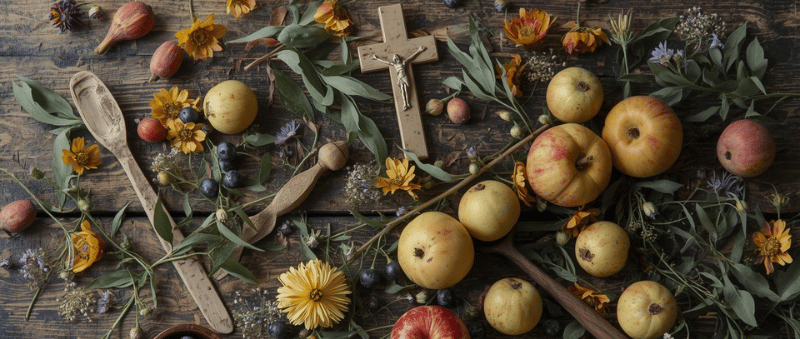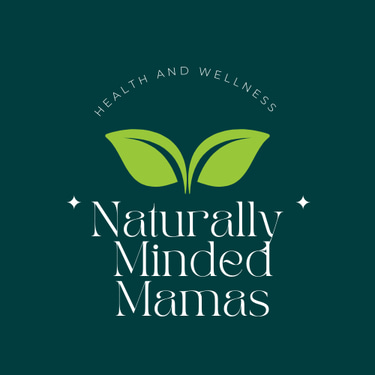From Backyard to Plate: The Unlimited Power of Wild Foods
Discover 400+ edible wild plants and natural herbal remedies with The Forager's Guide to Wild Foods. Learn safe plant identification, medicinal uses, and sustainable foraging for toxin-free family living. Includes dandelion recipes, mullein for coughs, wild lettuce pain relief & more. Perfect for low-tox moms seeking self-sufficiency.


The Forager's Guide to Wild Foods Review: Learn Edible Plants & Herbal Remedies for Natural Family Wellness
When I first started learning about herbal remedies and foraging, I remember feeling completely overwhelmed. Which plants are safe? How do I even identify them? What if I pick the wrong thing and accidentally poison my family?
If you can relate, then I hope this review puts your mind at ease. Although it might feel intimidating at first, learning to forage is not only doable—it's one of the most empowering skills you can develop for your family's health and self-sufficiency.
St. Hildegard of Bingen, the 12th-century abbess and renowned herbalist, believed that God placed everything we need for health in nature. She wrote extensively about the healing properties of plants, teaching that our bodies are designed to work in harmony with creation. Her wisdom reminds us that plant knowledge isn't "new age"—it's ancient, faith-rooted practice that honors God's provision.
I recently discovered The Forager's Guide to Wild Foods by Dr. Nicole Apelian, and after diving into it, I can honestly say this is THE resource I wish I'd had when I started my natural wellness journey. Gone are the days of squinting at tiny black-and-white plant sketches or worrying about dangerous lookalikes. This guide makes foraging accessible, safe, and genuinely exciting.
Let me walk you through why this book is worth adding to your natural living toolkit.
Why learn to forage in the first place?
There are so many reasons you might be drawn to foraging. Maybe you're:
Looking to expand your herbal remedy arsenal with wild medicinals
Wanting to reduce your family's toxic load by accessing truly wild, pesticide-free foods
Interested in self-sufficiency and being less dependent on supply chains
Seeking a meaningful outdoor activity to do with your kids
Simply drawn to a more natural, connected way of living
Whatever your reasons, there are incredible benefits when you learn to identify and use wild plants:
For health:
Access to nutrient-dense superfoods (many wild plants have MORE nutrients than their cultivated counterparts)
Natural remedies for common ailments like coughs, pain, anxiety, and digestive issues
Truly toxin-free food (no GMOs, no pesticides, no chemicals)
For family:
Legacy knowledge you can pass to your children
Free food and medicine growing all around you
Crisis preparedness and food security
For connection:
Deeper relationship with nature and God's provision
Stress-relieving outdoor time
Confidence and self-reliance
Plus, foraging is a lot better for the environment than buying imported organic produce, and it's completely free.
What makes The Forager's Guide to Wild Foods different?
If you've ever looked at foraging books before, you may have been turned off by confusing descriptions, tiny photos, or overwhelming botanical terminology. I know I was! But this guide takes a completely different approach.
Here's what sets it apart:
Full-color, high-resolution photos: Each of the 400+ plants includes large, detailed images showing exactly what you're looking for. No more guessing—you can see the plant clearly from multiple angles.
Safety-first approach: Every single plant entry includes a "Poisonous Lookalike" section explaining the differences you should look for. As mamas, we need to be 110% confident we're keeping our families safe, and Dr. Apelian takes this seriously.
Distribution maps: You can search specifically for plants growing in your geographic area, so you're not wasting time learning about plants you'll never encounter.
Practical uses included: Beyond identification, you'll learn how to prepare each plant as food or medicine, when to harvest it, and even some time-tested recipes.
Written by someone who's been there: Dr. Apelian is a biologist and herbalist who lived with the San Bushmen hunter-gatherers, survived 57 days alone in the wilderness on the History Channel's show "Alone," and used natural medicine to manage her Multiple Sclerosis. She knows her stuff.
Plants you'll discover in this guide
Here are just a few examples of what you'll learn to identify and use:
For natural healing:
St. Hildegard of Bingen taught that "there is a healing power in all of creation." The plants below are perfect examples of this truth—each one offering specific remedies that our ancestors relied on for generations:
"Nature's Prozac" - A common backyard plant that relieves anxiety and promotes sleep. Just steep 1 tsp of fresh leaves in boiling water for 10 minutes.
Wild Lettuce - Contains lactucarium, a natural pain-reliever you can forage legally. Add it to salads or make a painkilling elixir for lingering discomfort.
Mullein - Wonderful for lung cleansing and fighting coughs. People with tuberculosis used to smoke it in makeshift herbal cigarettes to relieve never-ending coughs.
Coltsfoot - Its Latin name literally means "to act on cough." Perfect for unblocking airways and fighting colds and flu.
Reishi Mushroom - A powerful medicinal mushroom that Dr. Apelian credits (along with other remedies) for helping manage her MS symptoms for over 20 years.
Stinging Nettle - While painful to touch, when rubbed on painful areas of the body, it can actually decrease joint and muscle pain.
For feeding your family:
Dandelions - Stop pulling these "weeds"! Every 100g contains around 23g of protein and 25g of fiber. You can make delicious dandelion bread with them.
Lamb's Quarters - This "wild spinach" saved communities during the Great Depression and contains substantially more nutrients than cultivated spinach and kale.
Cattails - Survivalists call this the "supermarket of the swamp" because you can eat every part of it, even the pollen. A true four-season survival food.
Morel Mushrooms - Worth $50-200 per pound, these distinctive mushrooms grow in all 50 states with no similar lookalikes.
Amaranth - A common backyard plant with tiny seeds you can pop like popcorn! They taste nutty, are gluten-free, and the young leaves taste like spinach.
Gooseberries - While still illegal to grow in many parts of the U.S., there's no law preventing you from foraging them. A single bush can yield 12 pounds of berries year after year.
What you actually get
When you invest in The Forager's Guide to Wild Foods, you receive:
The Main Guide - 400+ plants with full identification features, safety information, medicinal uses, and preparation methods
BONUS #1: The Wilderness Survival Guide (Digital) - Skills for crafting resources from your surroundings, perfect for bug-out bags
BONUS #2: Household Remedies - How to Recover Naturally at Home (Digital) - Time-tested remedies including black radish cough syrup and vinegar socks
BONUS #3: 104 Long Lasting Foods You Can Make at Home (Digital) - Foods that don't require electricity or refrigeration, from a time before modern conveniences
All of this for just $37—less than a single meal out, but knowledge that can feed and heal your family for a lifetime.
My honest take on this guide
Here's what I appreciate most about this book: it doesn't create fear or overwhelm. Instead, it empowers.
The goal with foraging isn't to become a full-time off-grid homesteader (though you could!). It's about having options. It's about knowing that if you spot mullein growing wild, you have a natural remedy for your child's persistent cough. Or that those dandelions in your yard aren't "weeds" but free, organic superfood.
It's about progress, not perfection—just like everything else on our low-tox journey.
Some things I especially love:
The emphasis on safety: With the poisonous lookalike sections and multiple photo angles, you can forage with confidence.
The medicinal focus: As someone passionate about herbal remedies, I love that this goes beyond just "edible plants" to include healing properties and preparation methods.
The practical recipes: You're not just told "this is edible"—you're shown how to actually prepare and enjoy these foods.
The distribution maps: No wasting time learning about plants that don't even grow in your region.
The 60-day guarantee: You can keep the physical book even if you request a refund. Dr. Apelian genuinely wants this knowledge in people's hands.
How to get started with foraging
If you've decided to explore foraging, here's how I recommend beginning:
Start slow: You don't need to learn 400 plants overnight. Pick 2-3 common plants in your area and master those first.
Prioritize safety: Always use multiple identification features. When in doubt, don't consume it.
Learn in season: Focus on what's currently growing around you rather than trying to memorize everything at once.
Forage with purpose: Are you looking for medicinal plants? Edible greens? Focus your learning on what serves your family's needs.
Take the kids: This is incredible legacy knowledge to pass down. Let them help identify, harvest, and prepare wild foods.
Refer to the book: Even experienced foragers consult guides. Keep this book handy when you're out exploring.
A "food insurance policy" for uncertain times
As naturally minded mamas, we prepare. We plan. We think ahead for our families' wellbeing.
Having plant knowledge isn't just about saving money at the grocery store (though that's a nice bonus). It's about being prepared. It's about self-reliance. It's about knowing that no matter what happens—supply chain issues, economic uncertainty, natural disasters—you have skills to sustain your family.
Our grandparents knew these things instinctively. This knowledge used to be passed down generation to generation. But somewhere along the way, we lost it.
We can be the generation that brings it back. As St. Hildegard of Bingen wrote centuries ago: "God has given us the earth and all its creatures for our use, and we are to use them wisely and well." Learning to forage is one beautiful way to do exactly that.
Who is this guide for?
This book is perfect if you:
Are building an herbal remedy toolkit and want to expand beyond store-bought herbs
Want to reduce your family's toxic load by accessing truly wild, chemical-free foods
Are interested in self-sustainable living and preparedness
Want to teach your children valuable life skills
Are drawn to a more natural, connected lifestyle
Simply want to know what's growing around you and how to use it
It's NOT necessary if you live somewhere with absolutely no access to wild areas (though you'd be surprised what grows in urban environments!), or if you have zero interest in ever using wild plants.
Final thoughts
Transitioning to a natural lifestyle takes time, and foraging is just one piece of the puzzle. There's no reason to feel overwhelmed or rush the process.
But if you're feeling that gentle tug to deepen your family's self-sufficiency and connect more intentionally with God's provision through creation, I genuinely believe The Forager's Guide to Wild Foods is one of the most valuable investments you can make.
Start small. Learn to identify one plant in your area. Make your first wild dandelion bread. Harvest some plantain for a healing salve.
Each step matters, mama. Each bit of knowledge you gain is a gift you can pass to your children and grandchildren.
Because raising naturally minded kids means teaching them to recognize the extraordinary provision hidden in plain sight all around them.
👉 Get The Forager's Guide to Wild Foods here (currently $37 with 3 free bonuses + 60-day money-back guarantee)
Have you tried foraging with your family? What wild plants grow near you? Drop a comment below—I'd love to hear about your experiences or answer any questions!
Disclaimer: Always properly identify plants before consuming them, and consult with a healthcare provider before using herbs medicinally, especially if you're pregnant, nursing, or taking medications. This post contains affiliate links, which means I may earn a small commission if you make a purchase through my link, at no additional cost to you. I only recommend resources I genuinely believe will benefit your family's wellness journey.
